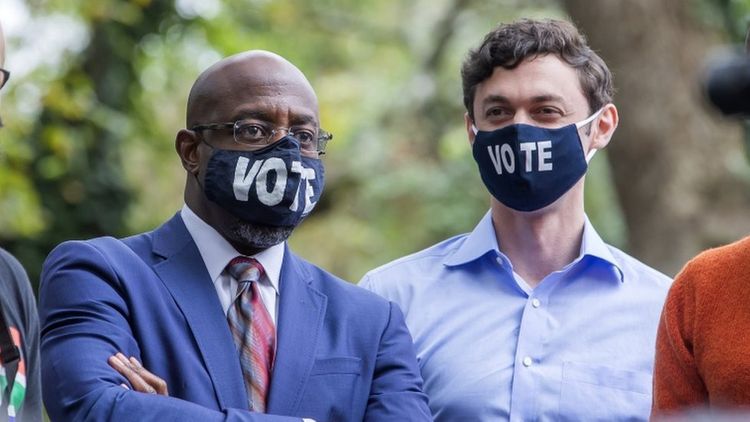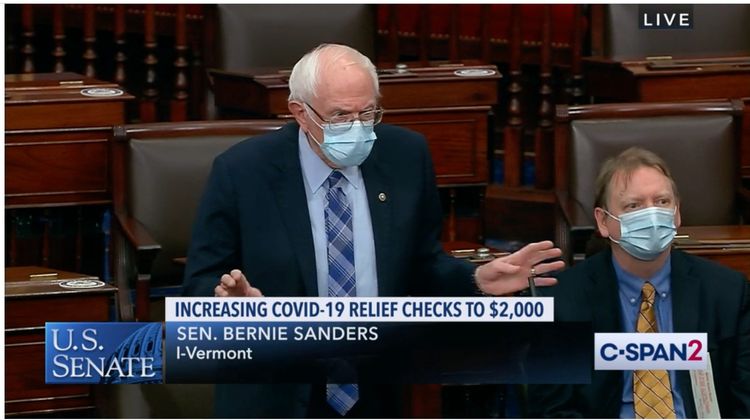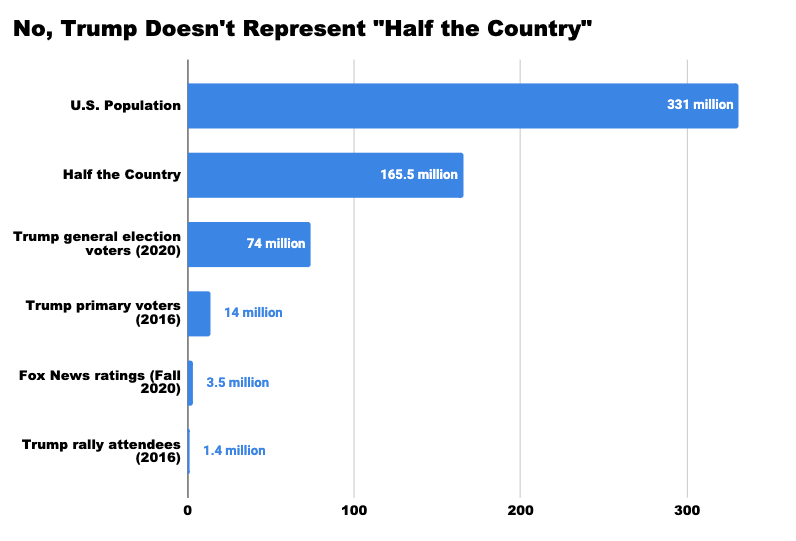Developing Effective Messages in Science Communication

There are a lot of tips, methods, schools of thought and best practices for developing effective messages in science communication. I like them all. Which is to say I don’t stick to just one method when it’s time to figure out how to explain a result, concept, project or proposal. As a communications professional I tend to view them all as tools rather than rigid formulas.
Think of it as the “Bruce Lee” method of message development. Lee was well known for developing his own style of martial arts based on identifying what is effective for an individual and discarding what is not. In his mind, picking any one style was simply too rigid given all the different strengths and weaknesses an individual might have and all the different contexts in which they might use their skills.
And not that science communication is a fight, but I think those general principles apply well here. For instance, some scientists are stupendous public speakers; others are much more comfortable with email correspondence. Some scientists love extended metaphors; some loathe them. Some scientists love coming up with snappy soundbites; others like to keep things simple and clear.

So here’s what I’ve taken away from the many message development systems out there and how I integrate them into my work. Importantly, this is just what I think right now. As new systems and new methods of communications evolve, I’m ready to integrate them into my approach. That said, the narrative based template describe below from scientist-turned filmmaker Randy Olson is incredibly powerful; it’s become the go-to for me in my day-to-day work.
Build and refine
When I approach any of these tools, my instinct is to get the basic messages down first and get them right. As university science public information officer Matt Shipman describes it, a communications staffer or journalist often needs to get to the point where they can explain it to themselves and then — huzzah! — they can explain it to other people. Even when scientists are working on their own, they should strive to get their main messages on paper first, even if they sound boring, and build and refine from there.
When we approach developing messages, we often start by spitballing one-liners, zingers and metaphors. It can be a lot of fun, but doing so can actually hold us back from thinking creatively because we revert to shooting down everything that might be construed inaccurately. This is especially true in science communication — in fact, it should be expected, darn it! — but it happens in other fields, too.
If we start with main messages instead, we can make sure the creative, memorable messages we want to develop later stay in sync with the core concepts we want to convey.
Then we need to use a little bit of the scientific method and test our messages out in the real world. A soundbite that feels right on, but doesn’t get picked up by journalists isn’t a great soundbite at all. A metaphor that leads an audience in the wrong direction has to be dropped. And that’s a good thing. Once we find messages that do work, we can use them for a lifetime.
Message Boxes and Talking Points
A message box or set of talking points is useful for several reasons, but the chief ones are practical. A good message box makes a researcher focus on the top few points they can reasonably get across to an audience. My old boss Rich Hayes also likes calling them a message “compass” because they can keep a researcher on track. We all dance around a bit when giving lectures, conducting interviews or meeting with a policymaker. A message box reminds us to hit the notes we know to be important. It also helps us avoid getting distracted or going down into the weeds at the expense of conveying what we know to be most important.
Scott Mandia, a meteorology professor and the winner of the American Geophysical Union’s ambassador award for service to the Earth science community, keeps his main messages in two important spots: on a sign above his desk so he can reference it when doing interviews and in his wallet so he can reference them wherever he’s working.
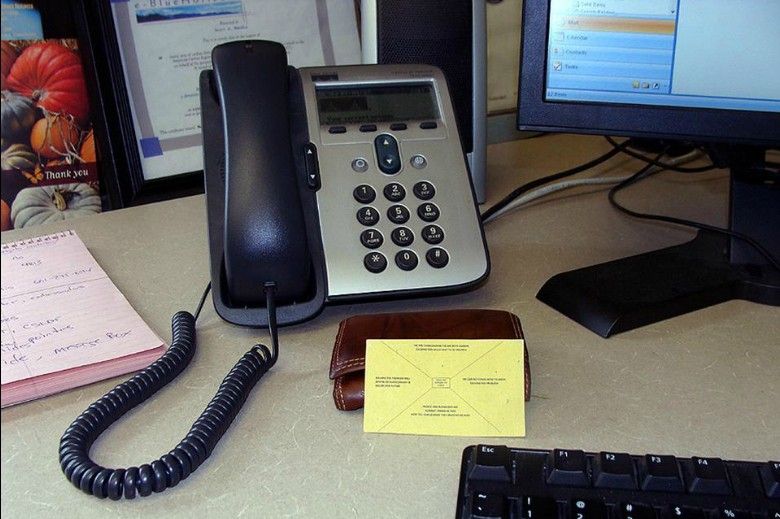
A message box isn’t meant to include everything one says in an interview or talk. Instead, it’s meant to highlight what is necessary to convey in an interview or talk. In this sense, creating a message box is an act of prioritization, which can be tough for scientists. They always want more context, more data, and more precision. But communications is limited. So we have to choose.
Message boxes can include sub-points, they can be modular and they can be as skinny or as detailed as the user wants. Scientists fall on a spectrum for how much or how little detail they want in a message box. Generally speaking, the more experience one has doing communication, the less one tries to include a message box. The details are usually in our heads and we can retrieve them at will; it’s the big picture messages that seem well-understood to us, but which aren’t to public audiences, that we need to remember to consistently emphasize.
Message Boxes: Getting Down to Business
A basic message template would follow along these lines:
- Here’s what we know.
- Here’s what’s new.
- Here’s why it matters.
Or put in science terms:
- The basic science.
- The new finding.
- The implications for scientists or society.
This template is derived from the classic A Scientist’s Guide To Talking With The Media from the Union of Concerned Scientists (UCS). Here’s an example of such a basic message template that I prepared for a workshop with public health researchers a few years ago when I was working at UCS:
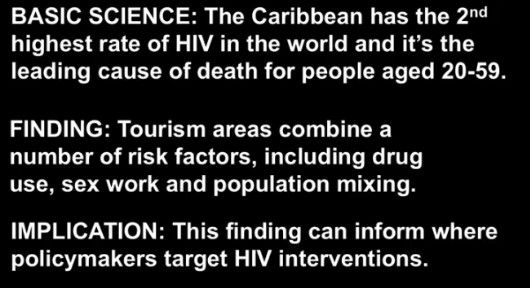
The implication, like the discussion section of a scientific paper, is the most free-wheeling part of this template. If a researcher were talking to a foundation funder, their implication might be: “That’s why we need more research funding for field studies in tourism areas.” For a scientific audience it might be: “That’s why we need to identify new protocols for collecting data in tourism areas.”
Of course, those seem like pretty straightforward main messages. Will people remember them? Or could you structure a talk around them? After developing a main message template, it’s worth thinking through how you can convey each of the messages to make them more memorable.
Here’s a punched-up version of that same message template:
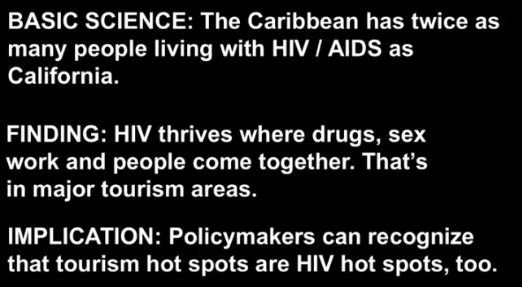
These messages are functionally the same, they’re just constructed like soundbites. The first uses social math that might be helpful for a lower-48-based audience, the second builds a tiny bit of tension by reversing the statement, and the third uses parallel construction and plays off the double meaning of “hot spot” in the context of tourism and studying diseases, respectively. (My next post will offer a taxonomy of soundbites, which builds off ones Hayes and his co-author, science journalist Daniel Grossman, developed.)
A template for science-based policy
For policy-relevant science, a slightly more complex message template adds a few more elements.
- Problem: What a project is trying to address.
- Solution: What research suggests can address the problem.
- Action: What steps or series of steps can flow from the studied solutions.
- Benefits: What societal goals could be served by following these actions.
This template builds off some lessons from Christine Jahnke, who hosts excellent communications workshops and is the author of The Well-Spoken Woman.
Here’s an example of some public health research about heat exposure and climate change in low-income, high-rise apartment buildings from Jalonne White-Newsome, a remarkably talented science communicator:
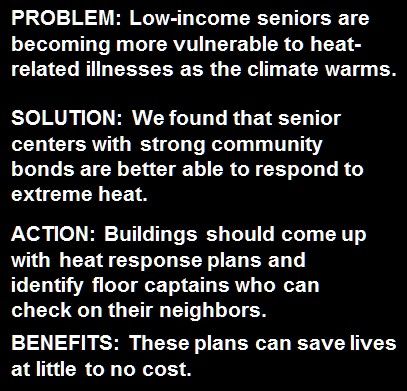
Note that the solution is general, but the action is specific. Many possible actions could flow from the analysis, but this was one we wanted to emphasize because people could act on it quickly and at no financial cost. Other actions included improving access to cooling centers — perhaps something to emphasize for a meeting with city planners — and reminding people to point their fans out the window to vent hot air instead of onto their bodies for temporary relief — a message one might emphasize for a one-on-one meeting with a senior.
And here’s a punched-up version:
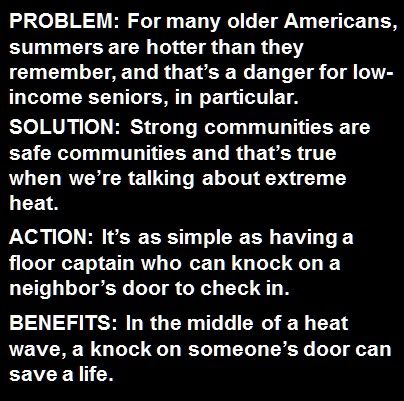
The first message uses people’s personal sense of time to connect back to changing climate patterns. The second uses some simple alliteration and the third paints a picture. The fourth juxtaposes the simplicity of the action with the gravity of the benefits.
When you start to come up with specifics like this, you can also see how the messages don’t necessarily have to go in this order, either. Imagine a TED-talk that opened with the benefit message: “What if a knock on your door could save your life?” Or imagine using the story of a specific floor captain as an intro. “I want to tell you about my research, but first I want to tell you about Gus…”
The variations are somewhat endless, which is kind of the point! There are no simple answers here and by consistently testing out new messages, one will find that the strongest survive.
Other message templates
The COMPASS message template is a popular one, especially among marine scientists. Sarah Myhre effectively used the organization’s template to help explain a set of papers she did about long term climate change and ocean life. The messages she developed were especially important for helping people understand that despite the dire nature of the findings that we still have a lot of societal choices to make about climate change.
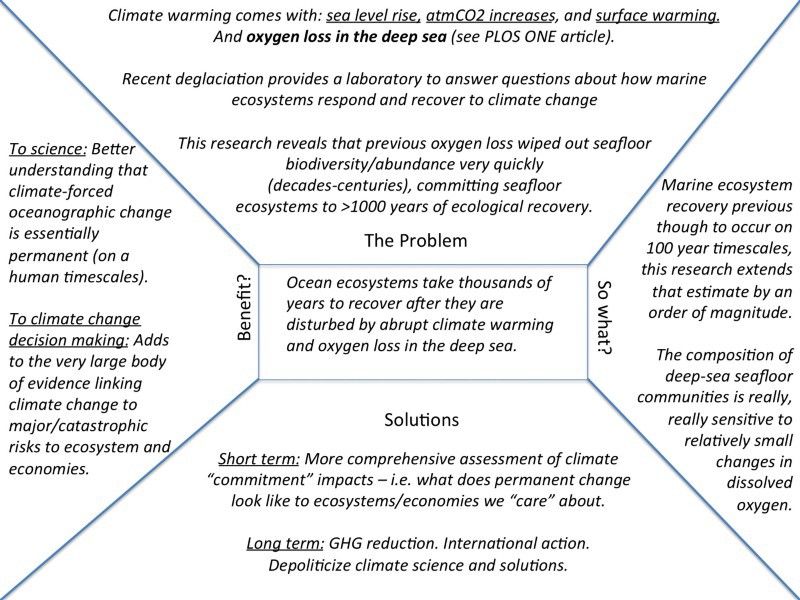
Note especially that Myhre included a lot of sub-messages in her template. This is a good example of a fully-fleshed out message box that starts with core messages and backs them up with sub-points, including ones she used for different contexts, such as discussing short-term and long-term solutions. Myhre’s message for other scientists?” Fill out yer damn message box.” It really forces you to grapple with the specific of what you want to say.
I’ve run into a few other templates, too. They all share common features and they’re all framed slightly differently, so I think finding the right template is a matter of testing multiple ones out over time to see what works for an individual.
But what about the methods?
This is going to hurt a couple scientists…but few people outside the scientific community care about the methods scientists use. Not all of our audience members are going to be mini-scientists. They kind of know how science works, they respect scientists as experts and they really do think science is great, but they generally just don’t care about data collection, statistical analysis, computer models or lab work.
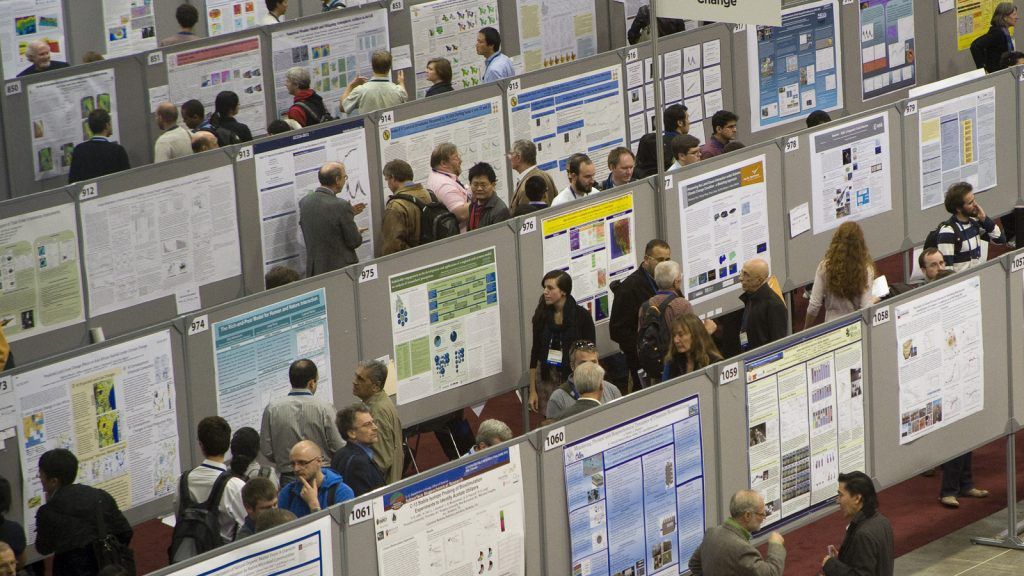
Are there exceptions? Sure. People who do field work have awesome stories about their methods. Sometimes we build great monuments to science like the James Webb space telescope or the Large Hardon Collider where the methods are part of the story. And sometimes methods are interesting because they’re particularly clever, novel, or relate-able. Other times methods involve the audience, especially when it comes to citizen science, so methods become a must for communication.
Additionally, when scientists find their work scrutinized in the press or by other scientists — or by interest groups or politicians — methods become part of the story, too, and scientists may even need to publicly defend them.
But most of the time methods aren’t that interesting to outside audience. So, yes, scientists should be ready to explain them if asked, but they don’t have to prioritize them as they do with a scientific audience.
Some scientists chafe at this. After all, we know how important the methods are for actually doing good science. In that case, I sometimes ask them to think about whether or not they would ask a financial advisor, a civil engineer or a electrician to talk to them about their methods. They all have methods, after all. But thinking about this in professional terms helps us see that for most people outside our field, it’s the results we care about, not the nitty-gritty of getting to them.
A final exception to excluding methods would be talking with beat and trade reporters. They totally want to know about methods because they follow the literature closely and want to know about new and interesting trends in research. A thirty minute conversation about the ins-and-outs of the latest and greatest — or not-so-greatest — in epigenetics is quite valuable for someone who translates science to a broader audience. Similarly, methods — and their success or failure — are sometimes a big part of a story, for instance, the demise of the National Children’s Study.
Okay, okay, but what’s the story?
Randy Olson, a scientist-turned filmmaker has written an incredibly useful book about narrative communication in science. Good stories, he writes, set the scene, identify a tension and attempt to resolve it. Olson draws a number of insightful parallels between how English majors and Hollywood use story structures and how we think and talk about science.
His “ABT” template is deceptively simple and remarkably useful. I’ve compared it to the arrow in the FedEx logo. Once you see it, you can’t unsee it.
ABT stands for “and, but therefore” and it under-girds the exposition, tension and resolution of a solid narrative structure. Olson uses the example of an unwieldy presentation he was working on with some coastal scientists. After some back-and-forth, they realized there was a big universal story they were trying to tell:
For 8,000 years sea level has been stable AND civilizations have been built right to the edge of the ocean. BUT for the past 150 years sea level has been rising rapidly, THEREFORE it is now time to come up with a new management plan for coastal areas.
Every other thing they were trying to communicate hung off those three thoughts. It occurred to me after reading Olson’s book that my own go-to-message templates pretty much followed the same structure.
From earlier, but with ABT annotations:
- Here’s what we know. (Here’s a thing AND another thing AND another thing…)
- Here’s what’s new. (BUT then we found a new thing!)
- Here’s why it matters. (THEREFORE, we concluded…)
Similarly, the four-part message template we looked at earlier treats the problem as an “and,” the solution as a “but” and takes the “therefore” and splits it into what can be done now (action) and why it makes sense to do so (benefits).
It really is all the same story structure and I often find myself looking at other people’s main messages and thinking, okay…but where’s the story? Or in other words…where’s the ABT?
Sometimes the idea of embracing narrative makes scientists uncomfortable. The word carries a connotation of inaccuracy because of its connection to works of fiction. But the best, most accurate science journalism also follows narrative structures. Narrative is just how humans make sense of the world and in some ways, what science does is give us better, more accurate stories to tell ourselves, over time, about how our world works. Olson goes further and argues that the current structure of a scientific paper also has narrative roots, few of which are taught in grad school, unless one studies the history of science itself.
At the same time, people who disparage science constantly abuse narrative to put out inaccurate information. When I reviewed Olson’s’ book last year, I recalled that I’d often pointed to the vaccine “debate” as one in which a misleading narrative did a lot of damage. For instance, here’s my attempt at what an ABT from an anti-vaccine advocate like Jenny McCarthy might look like, based on an interview she did with CNN:
Vaccines are widely administered AND no one questions them, BUT when my child received vaccines he became autistic, THEREFORE we need to be suspicious of vaccines.
It’s a dangerously inaccurate story, but it’s also a memorable one for some parents. Bummer!
Luckily, there are a lot of scientists who are more than willing and able to push back against these misleading narratives. And the good news is that vaccination rates remain high. But beating back a misleading narrative requires telling accurate stories, too. Trying to fight narrative armed only with “and, and, and” structured presentations of the facts is, in Olson’s telling, like trying to swim upstream against a too-strong current.
Paul Offit, a pediatrician who has invested considerable time and effort debunking misinformation about vaccines, has a go-to story he uses to explain how easily we can be misled. I asked Olson to watch an Offit interview I like to use for media workshops and translate his story into an “ABT.”
Here’s a slightly tweaked version of what he came up with:
My wife was getting ready to give a child a vaccine AND as she was pulling the shot into the syringe the child had a seizure BUT if the child’s seizure had come after the shot, it would have been very difficult to convince the parents they weren’t connected THEREFORE we can’t trust anecdotes, we have to trust and the scientific method.
Is that more complex than Jenny McCarthy’s story? Sure. But it’s also true. And it’s coming from a credible source. I showed this interview to a few public health researchers once and one of them told us that she’s heard Offit tell that story many, many, many times. That made me smile. As marketers will tell you, by the time you’re tired of repeating your message, it’s probably just starting to sink in. Clearly, Offit had found an effective story that painted a memorable narrative for his audience and one that helped illustrate his broader message: please, parents, trust the science.
As Olson emphasizes throughout his workshops, this isn’t an easy fix or just another tool to get good at storytelling — nor is it an add-on to good communication — it’s fundamental to figuring out effective, sticky messages that work for one’s audience.
Okay, but how does it make you feel?
My favorite question to ask scientists usually comes after we’ve figured out a few basic messages we want to convey: how does this make you feel?
When we consider this question, we allow ourselves to turn off our logical minds for a second and get to why we actually care about what we’re working on in the first place.
Like seriously answering a child who responds to every statement with “Why?” asking ourselves how we really feel about a topic eventually gets us to some fundamentals about why we do science communication in the first place: curiosity, excitement, worry, wonder, public service, the desire to heal pain, to create something new, or you know…
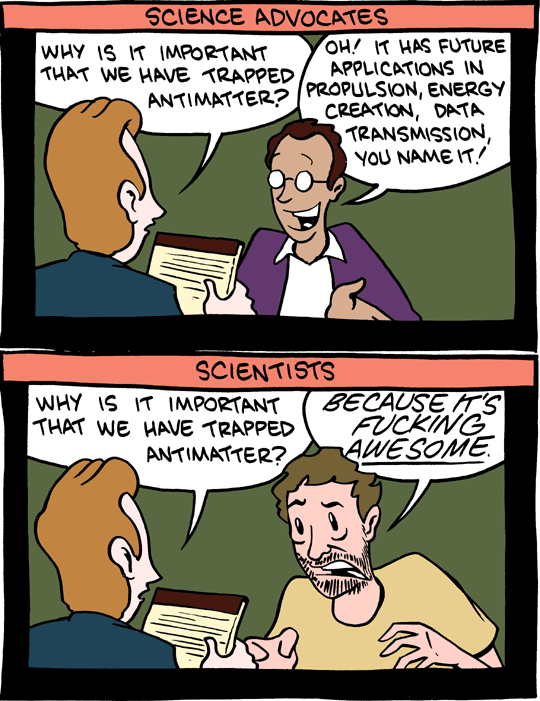
This also brings up a corollary question: what do we want our audience to feel? Hopefully, not boredom! We might want them to feel inspired, generous, angry or curious, too. I often ask myself this question in the context of social media sharing; why do I share the things I share online? What emotional trigger did a story hit for me that makes me want to tweet about it, comment on it or post it on Facebook? And what does posting that say about me to the people who follow me?
In practice, these are split-second decisions we make nearly every day. But at the level of message development, these questions are crucial for considering how and why people might share something online or in person.
I’ve also written before about how improv rules are useful for creative activities like message development or brainstorming new communications projects. If we’re clear that we’re just riffing and nothing is heading out the door without approval, it’s easier to say “yes” to the parts of the ideas we like, while savings the “nos” for later. Truly, when it comes to translating messages into soundbites, metaphors, compelling visuals or stories, we have to stop nitpicking to think creatively.
Create scaleable messages
I had an old rule that I liked to follow about main messages: stick to three and have no more than five. They can be backed up by sub-points, but three is usually as many as you want for a short media interview and a fourth message is a bonus.
As the communications landscape has changed, I’ve focused instead on another way of framing the question: what’s the one thing you absolutely want to say in an interview or with a specific audience? If you truly only had just 20 seconds to get your message across, what would it be? And what would you just beat yourself up over if you forgot to mention? Okay, now what else would you convey?
This suggests a different way of coming up with main messages, which is to prioritize them even more scrupulously. Such are the cognitive demands the modern communications environment places on us that sometimes we really only do have the chance to convey one message with a given audience. (This is another reason Olson’s ABT is so useful, by the way — it produces a short, standalone complete sentence.)
These questions are also useful because they help us think through how we can convey information at different timescales. My old colleague Matt Heid, who also blogs about outdoor gear and adventuring, often asked me what the 1 second, 10 second and 1 minute version of a message could be. That’s a great set of filters for thinking about how we share and consume information online, especially since it’s our attention which remains limited and distracted. One could similarly think about a 1 second headline message, a 10 second headline plus lead paragraph message, and a 1 minute and more message for people who are more engaged with the content one produces.
These filters work well in other contexts, too, depending on your audience. A good email needs an effective 1-second subject line. Trying to talk to a speaker at a packed conference after their session might be just a 10 second encounter. Make it count.
These attention span limits scale up, too. Another colleague, environmental engineer and science policy wonk Gretchen Goldman, produces briefing books to accompany new research. They include a quick rundown of top messages as well as an expanded version with sub-points to inform longer interviews or talks. Beyond that, one is often at the point of simply saying, “Thanks for your interest. Here’s an executive summary and the full paper for your reading pleasure! Woohoo!”
Messages that Don’t Work Are Not the Audience’s Fault
One final point: I wish these messages could all be more complex. I wish education were better, that critical thinking courses were a prerequisite in every public and private school, that people read more books, and that the political system did more to reward policymakers who rely on scientific expertise. I think everyone reading this blog feels the same way.
But that’s no excuse to throw our hands up and bemoan how hard it is to come up with messages that work. It just means we need to be more creative, more adaptable and more in tune with how people consume information. It also means being aware of our own biases; the messages that feel right for our fellow nerds can carry cultural baggage that make them duds or that backfire with other audiences.
The fun part of science communication, the challenging part, and the part that produces real moments of connection with our fellow citizens…those are the parts we remember. And those are the parts worth striving for and sharing with our colleagues, too.


